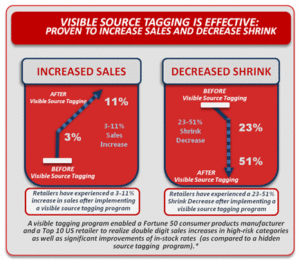 The retail industry loses billions of dollars a year due to shoplifting. And the small business owner that loses money due to shoplifting is a struggling business, without the resources the big retail chain has. Shoplifting, employee theft, organized crime, and even merchant theft, are major reasons why some small businesses close their doors for good. Shoplifters with a drug addiction problem are also a big problem for these businesses, because they enter their store to steal big quantities of merchandise to sell for cash to keep with their addiction drugs.
The retail industry loses billions of dollars a year due to shoplifting. And the small business owner that loses money due to shoplifting is a struggling business, without the resources the big retail chain has. Shoplifting, employee theft, organized crime, and even merchant theft, are major reasons why some small businesses close their doors for good. Shoplifters with a drug addiction problem are also a big problem for these businesses, because they enter their store to steal big quantities of merchandise to sell for cash to keep with their addiction drugs.
Prosecuting the shoplifter is always a hard decision for the small business owner to make, specially when they consider the financial burden attorneys’ fees will have in their business. A small quantity of small business owners choose to prosecute, but many choose to terminate the employee and deal with the loss instead.
For more about this and other topics about shoplifting, follow the links below.
It’s better to prevent addiction than cure
Addiction is powerful and destructive.
And there is no magic bullet, no magic cure.
Ask any alcoholic or drug addict in recovery and he or she will confirm that it takes perseverance and self-discipline to remain clean and sober, one day at a time, for the rest of his or her life.
What does this have to do with the American court system?
Empirically, addiction and crime go hand-in-hand. And people charged with crimes end up in court.
As a judge to whom thousands of criminal cases have been assigned, I have detected patterns when it comes to substance abuse.
A horrific crime with unspeakable allegations? Methamphetamine addiction.
Property crimes, including burglary, shoplifting and auto theft? Heroin addiction.
Domestic violence? Child abuse/neglect or animal abuse? Alcohol and methamphetamine.
DWI? Alcohol and/or drugs, both legal and illegal.
Of course, this is not an exhaustive list, just patterns I have noticed in my courtroom. Additionally, there is often an overlay of mental illness, sometimes specifically brought about by years of chronic substance abuse.
Shoplifter stole food for drugs
A PERSISTENT shoplifter who stole to fund his drugs habit was handed a suspended prison sentence and warned that if he committed another offence he was likely to be jailed immediately.
Christopher Page pleaded guilty to eight charges of theft from a shop – seven of them from the same One Stop shop in Pinehurst. The total value of the goods stolen was more than £200.
James Burnham, prosecuting, told Swindon Magistrates Court on Wednesday that Page went into the One Stop on August 5 and took six packs of steak without paying. He returned just before 5pm on August 7 and picked up washing liquids and gels worth £67.80, putting them down his trousers and walking out. The following day he was back to steal milkshakes valued at £3.
Then on August 9 he put more washing liquids, five packs of bacon, sausages, shower gels and a packet of hot chocolate worth £35.45 down his trousers and left without paying.
On August 14 he took washing liquids and the following day he stole fabric conditioner and washing capsules to the value of £13.65. “He sold the items to buy food and drugs if they were not food or were high value,” explained Mr Burnham. Ten days later he was back at the One Stop but this time he was seen hiding three boxes of Ferrero Rocher worth £19.50.
Good start in tackling gun violence-drug addiction problems
I attended two meetings recently that provided me with valuable information about problems in our community.
The Heroin Awareness meeting presented by the City of Myrtle Beach was excellent. I hadn’t realized the extent of the problem. My heart aches for those addicted and their families. Many try heroin because of peer pressure and become addicted. Others had been taking prescription meds for pain, became addicted, and then turned to heroin. Some overdose the first time they try it. Some go through many painful withdrawals before they are finally able to stay clean. Drug addicts are responsible for many crimes of shoplifting, burglary and prostitution in order to feed their habits.
I hope this Heroin Awareness program will be offered again to a countywide audience and especially students. Was the whole program filmed? If so, could it be shown in schools and community groups?
I also attended an Horry County Democratic Party Committee meeting on gun sense. We are seeking information so that we can understand how gun violence can be reduced. Horry County officers Wyatt and Conti were generous with their time and knowledge.

 Retail alarms are necessary to ensure a store is protected against break-ins and even theft from within. I know from personal experience that they work. As a Loss Prevention Manager I once had to respond to a burglary alarm when two young men threw a cement block through the front doors of my store in the middle of the night. I also responded to a number of false alarms due to system errors and failures. As a Manager On Duty I know that it can be stressful wondering if you locked all the doors and set the alarm at the end of the night. With those situations in mind, I would like to provide some practical tips to help avoid excessive false alarms and worry about building security.
Retail alarms are necessary to ensure a store is protected against break-ins and even theft from within. I know from personal experience that they work. As a Loss Prevention Manager I once had to respond to a burglary alarm when two young men threw a cement block through the front doors of my store in the middle of the night. I also responded to a number of false alarms due to system errors and failures. As a Manager On Duty I know that it can be stressful wondering if you locked all the doors and set the alarm at the end of the night. With those situations in mind, I would like to provide some practical tips to help avoid excessive false alarms and worry about building security.



 a good example using one of the newer clear, Checkpoint Systems stock labels. The trademarked “lock” and wording has been tested extensively.
a good example using one of the newer clear, Checkpoint Systems stock labels. The trademarked “lock” and wording has been tested extensively.

 How do I approach a shoplifting incident? This question is asked of me almost on a daily basis by store managers and owners. We always give advice and best practices on how to deter a shoplifter by using EAS devices, but what should you actually do if you are faced with a shoplifting incident that you personally witness? When should you call the police? When can you legally detain someone? While not every situation is the same, there are some basic best practices to follow. Here’s what I train my managers and can be a great starting point for you.
How do I approach a shoplifting incident? This question is asked of me almost on a daily basis by store managers and owners. We always give advice and best practices on how to deter a shoplifter by using EAS devices, but what should you actually do if you are faced with a shoplifting incident that you personally witness? When should you call the police? When can you legally detain someone? While not every situation is the same, there are some basic best practices to follow. Here’s what I train my managers and can be a great starting point for you.